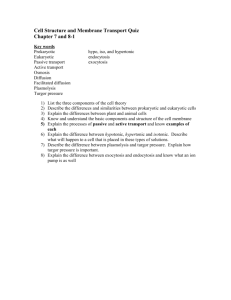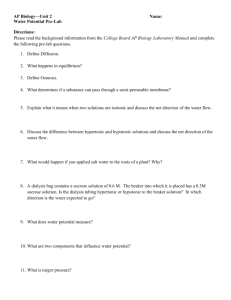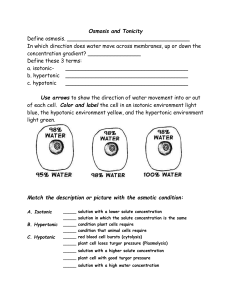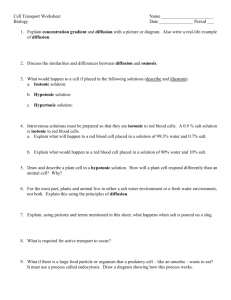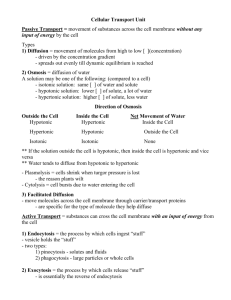Bio - Chaptert 5 - Homeostasis and Cell Transport
advertisement
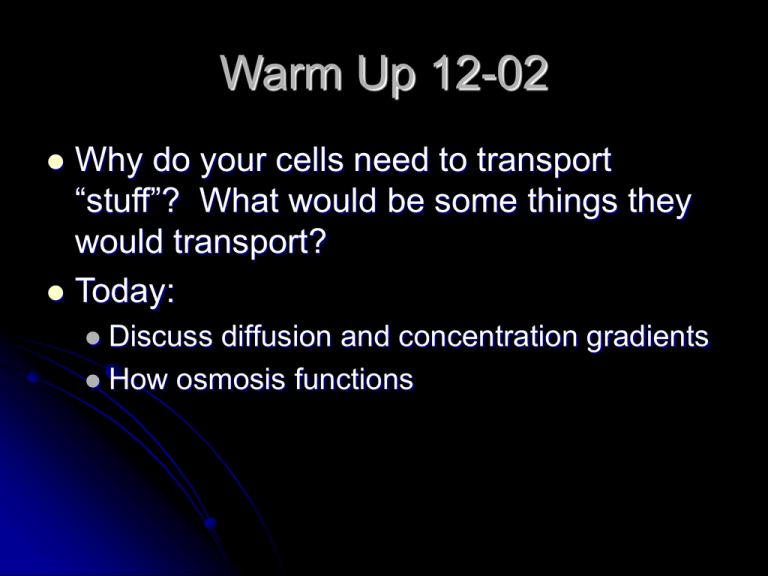
Warm Up 12-02 Why do your cells need to transport “stuff”? What would be some things they would transport? Today: Discuss diffusion and concentration gradients How osmosis functions Warm UP 12-3 Explain how diffusion works, including the concentrations needed for the substance to move Today: Begin egg lab Solutions (hypotonic, hypertonic, isotonic) Homeostasis and Cell Transport Chapter 5 Diffusion – the net movement of particles from an area of higher concentration to an area of lower concentration Occurs because of the kinetic energy in molecules (random movement) DEMO Diffusion in Water EX: Food dye slowly diffuses b/c of the movement of the water molecules and the dye particles Diffusion in air EX: The odor molecules bounce against each other and the gas molecules in the air and slowly diffuse into the classroom. Concentration Gradient – difference in concentration of molecules across a distance Dynamic Equilibrium – the condition in which there is continuous movement but no overall change This means there no longer is a concentration gradient there equal is no “high” and no “low” – everything is Osmosis – the diffusion of water molecules through a selectively permeable membrane Diffusion of water goes from high concentration to lower concentration http://www.youtube.com/watch?v=sdiJtDRJQEc&feature=related Draw Which way will the water move? Solution Sucrose = 75% Water = 25% Cell Sucrose = 25% Water = 75% Cell Sucrose = 65% Water = 35% Solution Sucrose = 35% Water = 65% Where will the water move? What will happen? http://images.google.com/imgres?imgurl=http://w ww.goldiesroom.org/Multimedia/Bio_Images/06 %2520Transport/06%2520Osmosis.jpg&imgrefu rl=http://www.goldiesroom.org/Note%2520Packe ts/06%2520Transport/00%2520Transport-WHOLE.htm&usg=___jLC2fuTVg2WoENLx6stG wDLC28=&h=296&w=590&sz=32&hl=en&start= 19&um=1&tbnid=so3zloAhuKV4nM:&tbnh=68&t bnw=135&prev=/images%3Fq%3Dosmosis%26 hl%3Den%26client%3Dfirefoxa%26rls%3Dorg.mozilla:enUS:official%26sa%3DN%26um%3D1 Reverse Osmosis 12-4 What is an hypotonic solution? What happens to the movement of molecule in an hypotonic solution? Then hand in your warm ups Today: Continue with the Egg lab (get out your lab sheet) Discuss turgor pressure, plasmolysis, hypertonic solutions Solution – Homogeneous mixture (a uniform mixture) of two or more substances Example: Solute: Substance that is dissolved in another substance Solvent: Salt and Water Thing that the solute is dissolved in What is the most common solvent? Water Biology Warm Up 12-07 Describe why water leaves the cell in a hypertonic solution. Today: Continue with the lab Worksheet Warm Up 12-08 Draw a graphic organizer for hypotonic, hypertonic and isotonic solutions. Tell me which way the water moves for each and what happens to the cell Today: We will finish our egg lab today Take notes on turgor pressure and plasmolysis Bio Warm Up 12-10 1. 2. 3. Get out a clean piece of paper you can turn in Questions: What is osmosis? What is a hypertonic solution? What happens to the cell in this type of solution? What is a hypotonic solution? What happens to the cell in this type of solution? Isotonic Solution – a solution in which the concentration of solutes outside the cell (ex: salts) is the same as the concentration of solutes inside the cell Would osmosis occur in this situation? No, because there is no concentration gradient (no net movement) Hypotonic Solution – solution in which the concentration of solutes (ex salts) is LOWER than the solute concentration inside the cell Which way will the water move? into the cell cell will swell / burst If we put Elodea leaves in a hypotonic solution, what happens? Water will move into the cell to dilute the salts – this causes the cell to swell Turgor Pressure – the pressure that exists inside a cell caused by water High turgor pressure can cause animal cells to burst. Why? They do not have a cell wall. What would happen if there is low turgor pressure in plants? Causes them to wilt Then you water the plant and it will regain the pressure and stand up straight Hypertonic Solution – solution in which the concentration of solute (ex salt) is higher outside than the concentration inside the cell Which direction will the water move? Out of the cell What will happen to an Elodea Leaf in a hypertonic solution? Water will leave the cell Plasmolysis – Water will leaves the cell, and result in shriveling of the cell Warm Up 12-11 What is plasmolysis? What would happen to the plant cell? What is turgor pressure? What happens to the plant if there is low turgor pressure? High turgor pressure? Today: Discuss plasmolysis and turgor pressure View the effects of a hypo / hypertonic solution on Elodea leaves Summary of Hypo/Hypertonic solution changes on a RBC. Biology Warm ATB 12-14 What is the function of the contractile vacuole? Why do some cells need them? Today: Turn in egg lab! 1st page - Rubric 2nd page – lab write up 3rd page – graph 4th page – lab direction sheet Assignment – read pages 97-102 Do Questions #1-8 Turn in when done ATB 12-15 What would happen to a grape placed in highly concentrated sugar water? Why would this happen? This Week: Test Friday! Today: Selective permeability Active transport Review If the cell shrinks, it is in what type of solution? If the cell is at equilibrium with it’s environment, its in what type of solution? If the cell swells, it’s in what type of solution? Water –90% Water 95% Salt – 10% Salt 5% Water 50% Water 50% Salt 50% Salt 50% Water 64% Water 44% Salt 36% Salt 56% Contractile Organelle Vacuoles – that excretes excess water from cells Uses energy Usually found in unicellular freshwater organisms. This prevents them from bursting in a hypotonic solution. Contractile vacuole Plasmolysis – loss of turgor pressure in plant cell due to loss of water What happens to a plant during plasmolysis? The plant wilts The plants plasma membrane and cytoplasm will shrink away from the cell wall Starting Mass (grams) Egg Lab Report Graph Must be colored Graph your starting mass and then use your final mass data which is in blue Egg in shell Vinegar Corn Syrup Distilled “Percent Change in Mass” Change in mass (g) % Change in Mass ((Initial Mass – Final Mass) / Initial Mass) x 100 Add a column to you data table: Final Mass (g) ((Initial Mass – Final Mass) / Initial Mass) x 100 Calculate all the changes in mass for your egg ===== ==== === Egg Lab Report Analysis of your Data: Be sure you are using the terms we’ve discussed in class in your explanation of your results. Example What you should turn in: Page 1 – Directions Page 2 – Written lab report Page 3 – Graph Page 4 – Your actual lab procedure Selective Permeability – plasma membrane to allows some materials to pass while keeping others out Why is selective permeability important? So the cell can allow important substance in (water, oxygen, glucose) and keep harmful substances out (bacteria). Passive Transport Passive Transport – movement of particles across membranes by diffusion This process uses no energy Molecules low conc moving from hi conc Facilitated name Diffusion – for passive transport using transport proteins Does not use energy!!! Example: – going from high conc. Outside cell low inside the cell Glucose Transport through the cell membrane: Transport proteins – proteins that assist facilitated diffusion Warm Up 12-16 What is the function of transport proteins? What is the function of the ion channels? TEST FRIDAY! RS due Friday! Today: Finish notes – Na + / K + pump, endocytosis, exocytosis Ion channels – proteins – transport ions from high concentration to lower concentration Ions (like Na+, Ca+, etc) are not soluble in lipids, so they must travel through proteins channels Ion channels are ion specific Some channels are always open, some have gate Gates open from stimuli: stretching of cell membrab., electrical or chemical signals Active Transport Active Transport – transport of materials against a concentration gradient – requires energy ATP (adenosine tri-phosphate) – the ENERGY molecule for the cell Breaks down from ATP ADP (Adenosine di-phosphate) Hydrolysis of the phosphate releases energy Active Transport Example http://www.youtube.com/watch?v=STzOiRqzzL4&feature=related Sodium-potassium Pump – transfer protein example Transfers Na+ out and K+ in Creates electrical gradient Important for nerve impulses http://www.youtube.com/watch?v=bGJIvEb6x6w&NR=1 Na+ / K+ Pump Endocytosis – when a cell surrounds and takes in material from the environment Uses ____Energy___ Warm Up 12-17 Draw a picture illustrating endocytosis Test / RS tomorrow! Today: Review for test Work on review sheet Endocytosis Pinocytosis – Transport of fluids into the cell Phagocytosis – Transfer of large particles / cells into the cell Phagocytes – Cells that ingest bacteria / viruses – lysosomes fuse w/ vesicle to destroy them before harm done http://www.youtube.com/watch?v=1w10R9lv7eQ Exocytosis – when a cell expels materials to the extracellular environment Cell exports proteins, hormones and wastes this way This process uses ___Energy___ Endo / Exocytosis Exocytosis and endocytosis http://www.youtube.com/watch?v=K7yku3 sa4Y8 The End Hypo / Hypertonic Solutions
